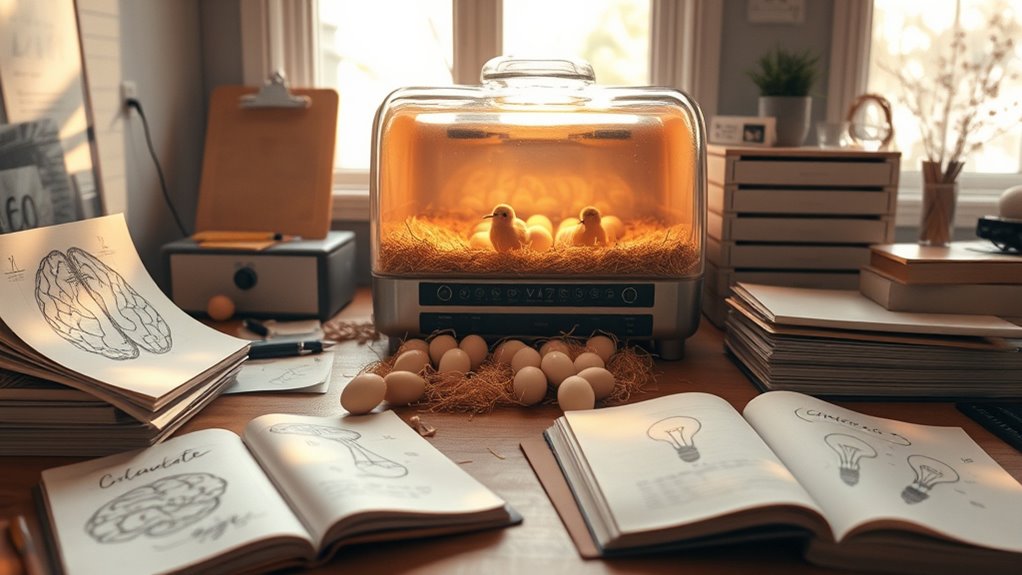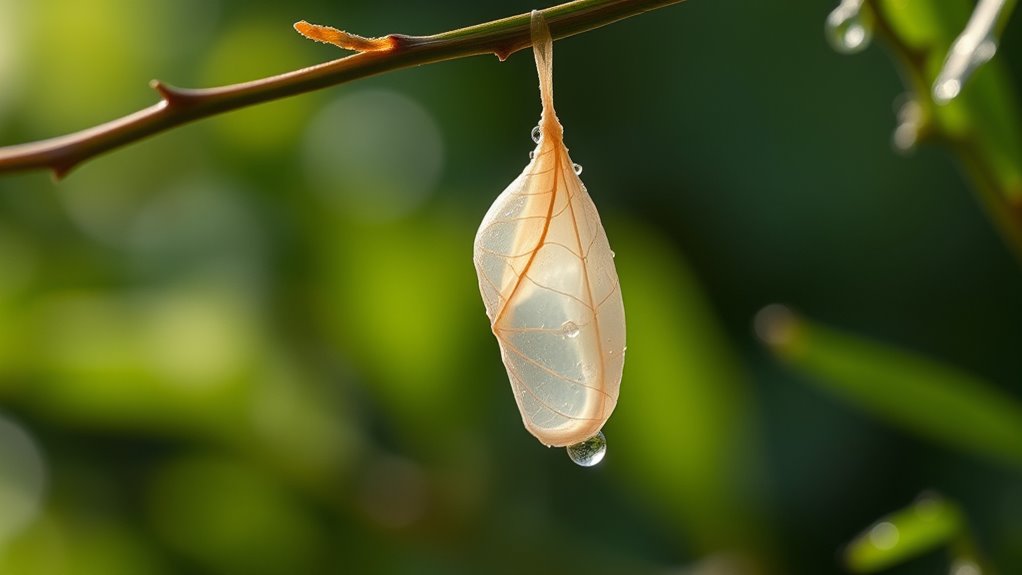Taking breaks during problem-solving lets your brain work unconsciously on the issue, a process called incubation. When you relax or step away, your mind drifts, making new connections and surfacing insights you might miss when focused. This mental drift and subconscious processing often lead to sudden “aha” moments. By practicing mindfulness or brief walks, you encourage these creative breakthroughs. Keep exploring—there’s more behind how breaks can uniquely boost your innovation.
Key Takeaways
- Breaks allow the brain’s unconscious processes to analyze complex problems without active effort.
- Incubation periods facilitate mental drift, helping subconscious cues surface and form new connections.
- Relaxation reduces mental clutter, creating clarity for innovative insights to emerge.
- Strategic downtime encourages subconscious problem-solving, increasing chances of creative breakthroughs.
- Mindful reflection during breaks captures emerging insights and enhances the incubation process.
The Science Behind Incubation and Creativity

When you step back from a problem, your brain continues working on it unconsciously, a process known as incubation. During this time, your mind wanders, drifting away from focused thinking. This mental drift allows subconscious cues to surface, subtly guiding your thoughts without your awareness. These cues can trigger new connections or insights that weren’t apparent before. As your mind wanders, it filters through information, making associations that active problem-solving might miss. This effortless process taps into your brain’s natural ability to process complex information behind the scenes. By allowing yourself breaks, you give your subconscious the space it needs to work, increasing the chances of creative breakthroughs when you return to the problem.
How Unconscious Processing Leads to Breakthroughs

Unconscious processing plays a crucial role in fostering creative breakthroughs by continuously analyzing information beneath your awareness. During periods of mind wandering, your subconscious works quietly, making connections you might not realize consciously. This process can lead to surprising insights, often sparking those “aha” moments. When your mind drifts, it allows your brain to process complex problems without pressure, opening space for subconscious insights to emerge. Additionally, practices like meditation can enhance this process by cultivating mental clarity and openness. This relaxed mental state encourages the brain’s neural networks to explore new associations and ideas beyond conscious control. Engaging in mindful breathing exercises can further support this unconscious analysis by calming the mind and reducing mental clutter. Moreover, research shows that incubation periods enable the subconscious to work on problems in the background, increasing the likelihood of breakthrough ideas. The brain’s ability to subconscious processing is essential for transforming diffuse thoughts into concrete solutions. Below is a quick comparison:
| Conscious Focus | Unconscious Processing |
|---|---|
| Deliberate problem-solving | Mind wandering triggers subconscious analysis |
| Requires effort | Happens passively in the background |
| Limited scope | Broad, connecting distant ideas |
| Immediate feedback | Insights often come unexpectedly |
Embrace breaks and mind wandering—they’re key to releasing your creative potential.
The Role of Relaxation in Problem Solving

Have you ever noticed how taking a break can suddenly make a tricky problem clearer? That’s because strategic relaxation allows your mind to reset and process information unconsciously. During this time, mindful reflection helps you gain new perspectives without forcing solutions. When you step back, your brain continues working behind the scenes, connecting ideas in ways you might not immediately recognize. Relaxation reduces mental clutter, fostering clarity and insight. In fact, research shows that incubation periods are essential for creative problem-solving, as they give your subconscious time to work through complex issues. By intentionally engaging in mindful reflection during breaks, you give your subconscious space to incubate solutions. This pause isn’t wasted—it’s an active part of problem-solving. Strategic relaxation, combined with awareness, enhances your ability to see patterns and develop creative solutions, proving that sometimes, stepping away is the best way forward. Recognizing the importance of mental clarity can help you harness this process more effectively. Additionally, understanding the role of unconscious processing emphasizes how your mind continues to work even when you’re not actively focused on the problem. Incorporating rest periods into your routine can significantly boost your creative output and decision-making skills.
Practical Strategies for Harnessing Incubation Periods

To effectively harness incubation periods, you need to incorporate intentional strategies into your problem-solving routine. Start by scheduling downtime regularly, allowing your mind space to process ideas subconsciously. During this time, practice mindful reflection to identify emerging insights without pressure. Use prompts or journaling to capture fleeting thoughts. To help you stay organized, consider this approach:
| Strategy | Benefit |
|---|---|
| Scheduled downtime | Facilitates subconscious processing |
| Mindful reflection | Enhances awareness of emerging insights |
| Brief walks or breaks | Stimulates creative connections |
| Limiting distractions | Keeps focus on incubation activities |
| Tracking ideas | Monitors progress and sparks new thoughts |
Additionally, understanding incubation periods can help you recognize when your subconscious mind is actively working on a problem. Recognizing signs such as eureka moments can signal that your incubation has been productive. Engaging in activities like Gold IRA research can also stimulate your creative process by exposing you to new opportunities. Being aware of how vegetable juices impact cognitive function can further support your creative process. Incorporating knowledge about Glycolic Acid Benefits for Skin can be useful in nurturing your skin health during incubation breaks. These strategies make incubation periods more productive, turning breaks into powerful tools for insight.
Real-Life Examples of Breaks Fostering Innovation

Many innovators credit intentional breaks and downtime with sparking their breakthroughs. For example, famous inventors and creators often practice mindfulness meditation or engage in creative visualization, allowing their minds to relax and make unexpected connections. Steve Jobs, for instance, credited meditation with helping him think differently. These moments of mental clarity enable you to step back from problem-solving and see new perspectives. Breaks foster insight by quieting busy thoughts, creating space for spontaneous ideas to emerge. You might find that during a walk, a nap, or a meditation session, your mind drifts to solutions you hadn’t considered. Incorporating intentional pauses—like mindfulness meditation—can turn idle moments into fertile ground for creative problem-solving, proving that sometimes, stepping away sparks your greatest ideas. Additionally, understanding AI safety measures can inspire innovative solutions by exposing you to diverse narrative techniques.
Frequently Asked Questions
How Long Should an Incubation Break Last for Optimal Results?
For ideal results, you should tailor your incubation break to your needs, typically lasting 10-20 minutes. During this mindful pause or creative downtime, you allow your mind to reset and absorb information. Short breaks help prevent burnout, boost your focus, and spark new insights. Listen to your body and mind, and extend breaks if you feel overwhelmed. Consistent, mindful pauses enhance your overall productivity and creative problem-solving abilities.
Can Incubation Periods Be Intentionally Scheduled or Are They Spontaneous?
Did you know that 65% of successful breakthroughs come from spontaneous insights? You might wonder if incubation periods can be intentionally scheduled or if they happen spontaneously. The answer is both. You can plan intentional incubation by setting aside focused time for reflection, but spontaneous insight often occurs unexpectedly, triggered by your subconscious processing. Balancing scheduled breaks with openness to spontaneous moments fosters creativity and innovation.
Do Incubation Periods Differ Across Various Fields or Types of Problems?
You’ll find that incubation periods do differ across various fields and problem types due to cross-disciplinary differences and problem-specific durations. For example, scientific research might require extended incubation times, while creative brainstorming can have shorter ones. These variations help you adapt your approach depending on the challenge, ensuring you give each problem the appropriate amount of reflection and development time. Recognizing these differences boosts your problem-solving effectiveness and sparks fresh insights.
What Are Signs That an Incubation Period Is Working Effectively?
You’ll notice signs that your incubation period is working when you experience unconscious processing and mental refreshment. These signs include sudden insights, fresh ideas, or solutions emerging unexpectedly. You might feel more relaxed and less stressed, allowing your mind to freely explore different perspectives. Trust these signs—they indicate your subconscious is actively working, helping you break through mental blocks and spark new insights without direct effort.
How Do Individual Differences Influence the Incubation Process and Insight Development?
Like a unique fingerprint, your personal traits and cognitive styles shape how you experience insight development. You might find that breaks help your mind wander, revealing solutions others overlook. Your openness, patience, and problem-solving approach influence how effectively incubation fosters insight. By understanding these individual differences, you can tailor your strategies, ensuring your breaks maximize creative thinking and help you uncover hidden ideas more efficiently.
Conclusion
You might think taking breaks slows you down, but it actually sparks your creativity. By allowing your mind to rest and process unconsciously, you open the door to new ideas and insights. So next time you hit a wall, don’t push through—step back, relax, and trust that your subconscious is working behind the scenes. Breaks aren’t a pause; they’re a powerful tool for breakthroughs. Give yourself permission to pause and watch your creativity flourish.









